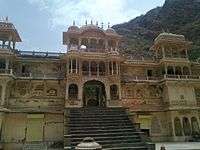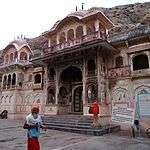Galtaji



Galtaji is an ancient Hindu pilgrimage site in the town of Khania-Balaji, about 10 km away from Jaipur, in the Indian state of Rajasthan. The site consists of a series of temples built in to a narrow crevice in the ring of hills that surrounds Jaipur. A natural spring emerges high on the hill and flows downward, filling a series of sacred kunds (water tanks) in which pilgrims bathe. The visitor or pilgrim ascends the crevasse, continuing past the highest water pool to a hilltop temple from which a magnificent view of Jaipur and its fortifications spreads out across the valley floor. It is believed that a Saint named Galav lived here, practiced meditation, and did penance (tpasya).[1]
Temples
Built within a mountain pass within the Aravalli Hills 10 km. east of Jaipur,[2] Galtaji has been a retreat for Hindu ascetics belonging to vaishnavite Ramanandi sect, since the early 16th century;[1] its present temple was built by Diwan Rao Kriparam, a courtier of Sawai Jai Singh II, in the 18th Century. The main temple is the Temple of Galtaji, built in pink stone. The temple features a number of pavilions with rounded roofs, carved pillars, and painted walls. The complex is set around a natural spring and the waterfalls that create two tiered pools, the upper and lower pool, used for bathing by pilgrims.[3]
There is another temple in the complex, the temple of Balaji. Built on the highest peak in the town of Galta is Diwan Kriparam, Sun Temple, dedicated to Surya, the Sun God in Hinduism and was built in the 18th century.[4]
Monkeys

The temple complex of Ramgopalji temple is colloquially known as Monkey temple (Galwar Bagh) in travel literature, due to the large tribe of monkeys who live here in the temples, which have been largely abandoned and only partially restored. These rhesus macaques were featured in National Geographic Channel's Rebel Monkeys series and "Thar Desert - Sacred sand" episode of Wildest India Series.
Water tanks
The temple is famous for its natural water springs, which draw special attention from visitors. The water of these springs accumulates in tanks (kunds). There are seven tanks, the holiest being the Galta Kund, which never goes dry. It is considered auspicious to bathe in the waters of Galtaji, especially on Makar Sankranti, and thousands come to bathe every year.
References
| Wikimedia Commons has media related to Galtaji. |
- 1 2 Vibhuti Sachdev; Giles Henry Rupert Tillotson (2002). Building Jaipur: The Making of an Indian City. Reaktion Books. pp. 39–. ISBN 978-1-86189-137-2. Retrieved 29 August 2013.
- ↑ Dr. Daljeet; P. C. Jain (Prof.) (2002). Monuments Of India. Aravali Books International Pvt. Limited. p. 161. ISBN 978-81-86880-76-0.
- ↑ AnnGrodzins Gold (1990). Fruitful Journeys: The Ways of Rajasthani Pilgrims. University of California Press. pp. 278–. ISBN 978-0-520-06959-6. Retrieved 29 August 2013.
- ↑ Travel House Guide to Incredible India. Travel House. 2004. pp. 92–. ISBN 978-81-241-1063-8. Retrieved 29 August 2013.
http://www.viewat.org/?i=en&id_pn=21092&sec=pn&tp_ctr=IN
Coordinates: 26°52′34″N 76°07′27″E / 26.8761°N 76.1242°E